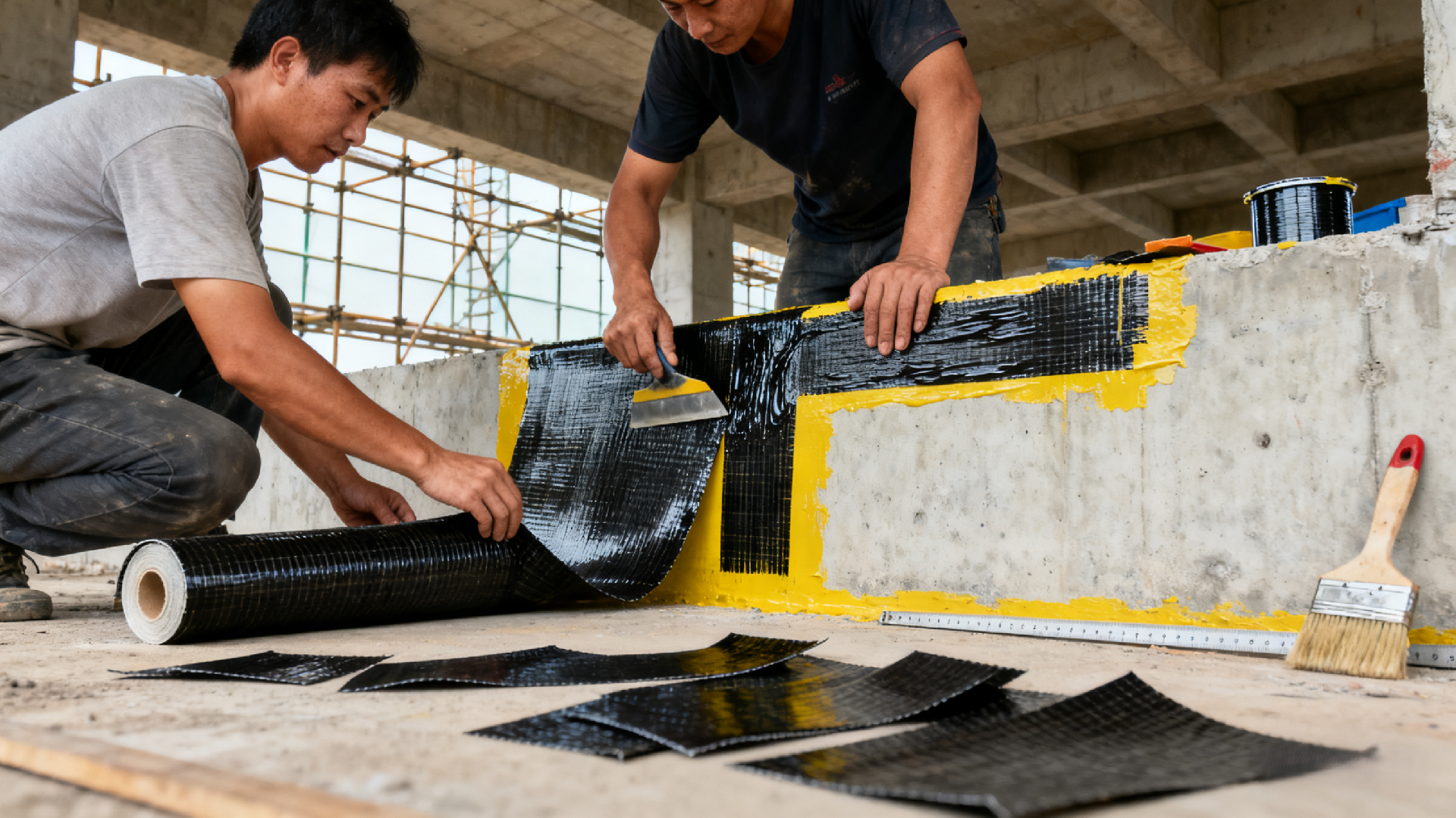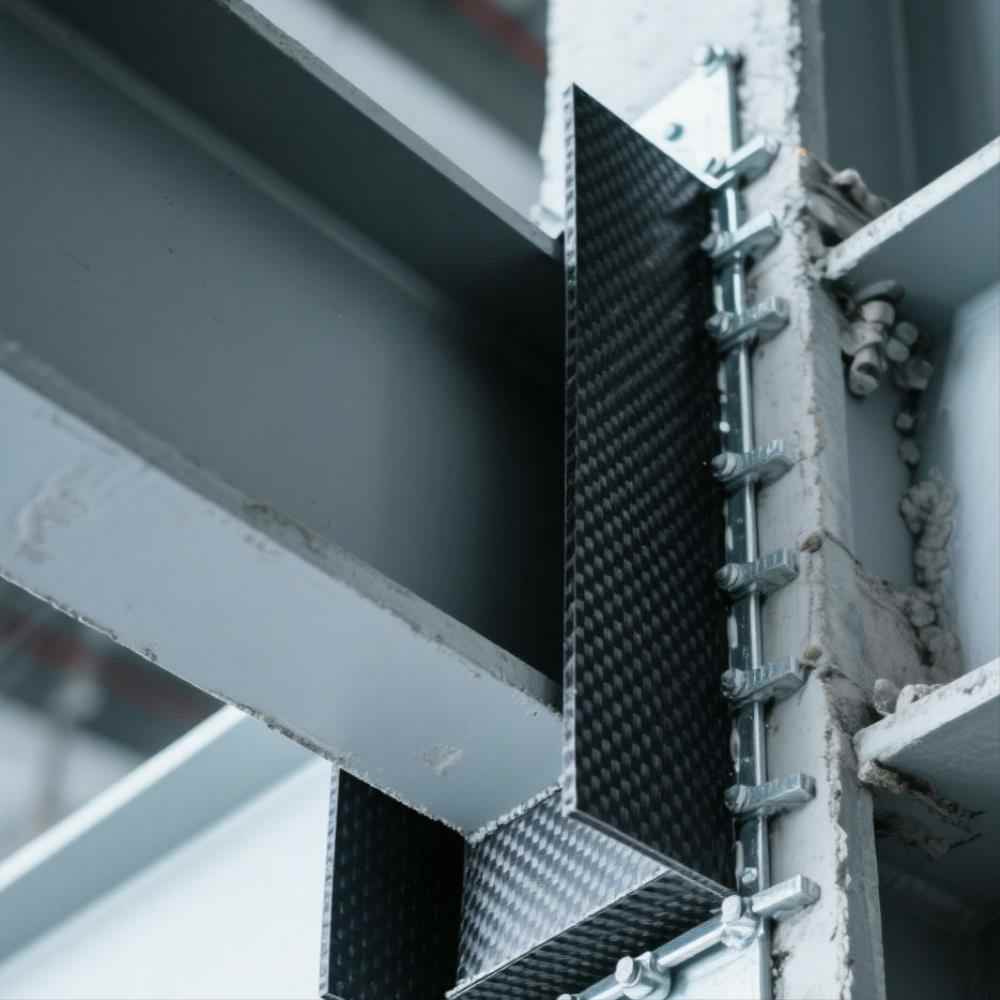
In the field of structural reinforcement, the application of carbon fiber materials has gradually become a common choice. As two important carbon fiber reinforcement materials, carbon fiber cloth and carbon fiber board play a key role in reinforcement and repair projects.
However, there are significant differences between them in terms of performance, construction methods and applicable scenarios.
1.Differences in performance characteristics
Carbon fiber cloth is typically a thin sheet of woven fibers. Its primary characteristics are its lightness, thinness, and flexibility.It possesses excellent tensile strength and corrosion resistance, effectively increasing the load-bearing capacity of the reinforced structure. Its flexibility allows it to conform to a variety of surfaces, making it suitable for reinforcing irregularly shaped or curved structures.
In contrast, carbon fiber panels are made from multiple layers of carbon fiber cloth through pre-impregnation, pressurization, and curing processes. Carbon fiber panels stand out in reinforcement for their high stiffness and strength, effectively controlling structural deformation and improving overall stiffness. Due to their relatively rigid nature, carbon fiber panels are more suitable for structures that require rigid support, such as beams and columns.
2.Differences in construction methods
Carbon fiber sheeting offers a relatively flexible construction method. During the reinforcement process, the sheet is first fixed to the surface being reinforced using an adhesive or impregnated adhesive. After curing, it forms a reinforced layer that adheres tightly to the structure. Carbon fiber sheeting is suitable for reinforcing various structural surfaces, and the construction process is relatively simple, requiring no extensive equipment.

The construction process of carbon fiber panels is relatively complex, typically requiring prefabrication in a factory and then transport to the construction site for installation. During installation, the panels are securely attached to the reinforced structure by drilling holes or using adhesives. Due to their high rigidity, their construction requires specialized equipment and techniques.

3.Different applicable scenarios
Due to its softness and adaptability, carbon fiber cloth is more suitable for scenarios that require flexibility, such as reinforcing cracks, resisting bending deformation, or improving the seismic performance of structures. It can fit tightly onto uneven surfaces for local reinforcement.
Carbon fiber panels are more suitable for scenarios where increased overall stiffness and strength are required. For example, in the reinforcement of long-span structures, carbon fiber panels can effectively control the deflection and deformation of the structure, improving its overall stability.
In practical applications, the choice between carbon fiber cloth and carbon fiber plate requires comprehensive consideration of the specific reinforcement situation and requirements. If overall stiffness needs to be increased, carbon fiber plate should be chosen; if local reinforcement is needed to accommodate curved surfaces or irregular structures, carbon fiber cloth is more suitable. Furthermore, a comprehensive assessment should be made based on factors such as project budget and construction schedule to select the most appropriate carbon fiber reinforcement material to ensure the reliability and durability of the reinforcement.
Ant Carbon can customize for any size and thickness of carbon fiber sheets and tubes.
A: Yes, we are absolutely welcome to buy sample order to test and check quality.
A: Absolutely. Our UV-resistant coatings prevent degradation, ensuring over 10 years of outdoor service life.
A: Designing parts for CNC machining involves several key considerations to ensure optimal manufacturability and quality. Here's a detailed breakdown of each aspect:
1. Simplicity: Keep designs as simple as possible to minimize machining time and cost.
2. Tolerances: Understand the machining tolerances of the CNC machine being used and design accordingly.
3. Tool Access: Ensure that tools can easily access all areas of the design for machining.
4. Material Selection: Choose materials based on the part's function, mechanical properties, and machining capabilities.
5. Minimize Internal Corners and Sharp Edges: Internal corners and sharp edges can be challenging to machine and may increase the risk of tool breakage. Minimize these features to facilitate tool movement and improve machining efficiency.
6. Uniform Wall Thickness: Design parts with uniform wall thickness to prevent warping and distortion during machining.
7. Fillets and Chamfers: Incorporate fillets and chamfers into your design to reduce stress concentrations and improve part strength.
8. Consider CNC Machine Size and Capabilities
Standard tolerances vary but typically range from ±0.005" (±0.127mm) to ±0.001" (±0.025mm) depending on the material and size of the part.
Yes, CNC machining can produce complex shapes. However, the more complex the design, the more time and resources are required, potentially increasing costs.
CNC machining is a subtractive process, removing material to create parts, while 3D printing is additive, building parts layer by layer. CNC machining is generally faster for producing metal parts and is superior in terms of strength and finish.
Yes, CAD (Computer-Aided Design) software is essential for designing parts for CNC machining. It helps in creating precise 3D models, which can then be translated into instructions for the CNC machine.
AI and machine learning can optimize machining processes, predict maintenance needs, and improve quality control, leading to increased efficiency and reduced costs.How Do I Choose a CNC Machining Service?When choosing a CNC machining service, consider their expertise, machinery capabilities, quality control processes, turnaround time, and cost.Can Small Quantities Be Produced Economically?Yes, CNC machining is suitable for small quantity production, especially for complex parts where mold or tooling costs for other manufacturing methods would be prohibitive.
STEP (Standard for the Exchange of Product model data) is an ISO standard exchange format used for representing 3D objects. It encodes detailed 3D data and is widely supported across different CAD software. STEP files are advantageous in CNC machining for several reasons:
Compatibility: STEP files are universally compatible with almost all CAD/CAM software.
Detail: They retain all the geometric and dimensional data of a part, essential for precision machining.
Flexibility: They can be easily edited, making them ideal for iterative design processes.
Carbon fiber CNC machining can provide a range of processing capabilities, including:
1. Cutting: CNC machines can precisely cut carbon fiber sheets into desired shapes and sizes according to CAD designs.
2. Drilling: Holes of various diameters can be accurately drilled into carbon fiber components for assembly or attachment purposes.
3. Milling: CNC milling can be used to create complex shapes and contours on carbon fiber parts with high precision.
4.Routing: Similar to milling, routing involves removing material from the carbon fiber using a rotating cutting tool to achieve specific shapes or profiles.
5. Engraving: CNC machines can engrave patterns, logos, or serial numbers onto carbon fiber surfaces for identification or branding purposes.
Don't miss any updates or promotions by signing up to our newsletter.